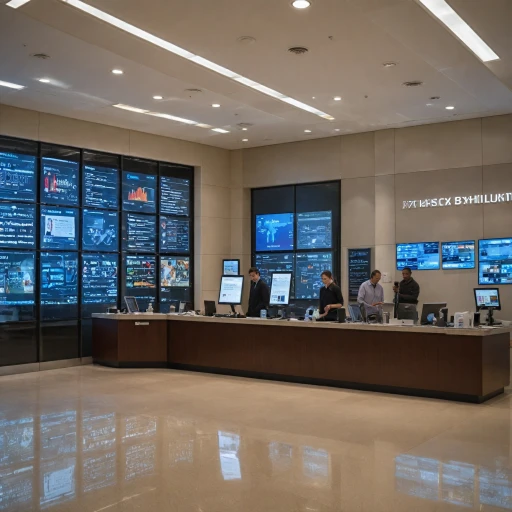Embracing a Customer-Centric Culture: More Than Just Service
A Transformational Shift Toward Customer First
In the heart of every thriving business is a steadfast dedication to customer satisfaction. It's more than just delivering exceptional customer service; it's about embedding customer-centric values into the company's DNA. Top-tier organizations recognize that every decision, product development, and marketing campaign must pivot on the axis of customer needs and desires.
Expert views like Peter Fader, author of 'Customer Centricity: Focus on the Right Customers for Strategic Advantage,' have long illuminated the path forward, emphasizing the significance of a customer-centric strategy. Statistics bolster this viewpoint – according to a PwC report, a staggering 73% of consumers point to customer experience as a determining factor in their purchasing decisions.
In Pursuit of Customer-Centricity
What sets customer-centric companies apart is their unwavering commitment to their consumers. Amazon and Apple, leading voices in the chorus of market leaders, orchestrate their operations to resonate with customer needs. Jeff Bezos, the mastermind behind Amazon's colossal success, championed the phrase 'customer obsession,' a philosophy that has become a cornerstone of their operational manifesto. This approach is echoed by companies like Zappos and Nordstrom, who are renowned for their customer satisfaction zeal.
It's a compelling narrative that a customer-centric approach not only wins over customer loyalty but also fosters innovation. With social media as a prominent tool, businesses are now leveraging these platforms to connect with their audience more intimately. Starbucks, for instance, utilizes customer feedback on social media to refine their products, demonstrating how modern companies adapt to the rhythm of the market while keeping the customer's voice at the forefront.
Cultivating an Organization with Heart
The pivot to customer-centricity requires a blend of long-term vision and careful crafting of company culture. It insists on evolving from a product-driven to a customer-led enterprise. As Leonard L. Berry stated in his seminal work, 'Discovering the Soul of Service,' organizational culture is the fertile ground from which the seeds of customer centricity sprout.
Creating a customer-centric culture signifies an in-depth understanding of the customer beyond demographics and sales data. Customer data must translate into meaningful insights that drive strategic decisions—pointing towards a customer centric strategy that rests on knowing not just who your customers are, but why they gravitate towards your company's products or services.
And what of the challenges that companies face along this journey? Maintaining this focus is an ongoing process, and as customer needs shift, so must the fabric of the business. Building customer loyalty is not a one-time event but a relentless pursuit that stands the test of time and market rhythms.
For those seeking to delve deeper into strategic insights for mastering customer-centricity, don't miss decoding consumer behavior as it is key to strategic dominance in today's competitive marketplace.
The Anatomy of Customer-Centric Companies: Lessons from Market Leaders
The Blueprint of a Customer Centric Company
At the heart of any successful business lies its ability to cater to the needs of its customers. A customer-centric company doesn't just pay lip service to the concept of putting customers first; it embeds it into the very DNA of its organization. Bringing this idea to life is much like a maestro conducting a perfectly attuned orchestra, with each section contributing harmoniously to deliver a mesmerizing performance.
Case Studies: Giants of Customer Centricity
When we look at market leaders such as Amazon and Apple, their relentless focus on customer satisfaction is evident. Amazon's founder, Jeff Bezos, often highlights the importance of being customer-obsessed – and the stats speak for themselves. With a consistently upward revenue trajectory, they've turned customer centricity into a profitable art form. It’s a similar tune for Apple, whose resounding success echoes the vitality of understanding what customers love about their products and incessantly innovating to enhance their experience.
Expert Opinions on Customer-Centric Enterprises
Peter Fader, co-founder of Theta Equity Partners and author of 'Customer Centricity: Focus on the Right Customers for Strategic Advantage', advocates that not all customers are created equal. Apple's loyal customer base is a testament to Fader's principal that catering towards the more valuable customers drives greater profitability in the long term. Names like PwC and Deloitte have published extensive reports detailing the manifold benefits that a centric culture affords a business, from heightened customer loyalty to improved market performance.
Metrics That Matter
Key indicators like the Net Promoter Score (NPS) offer businesses a quantifiable gauge of customer sentiment. This tool has proven invaluable for companies in measuring satisfaction levels and predicting customer loyalty. In a study by Harvard Business Review, the correlation between high NPS scores and organizational growth rates illustrated the paramount importance of centric strategies in fostering long-term success.
Navigating Market Rhythms with a Centric Approach
Understanding the Pulse of the Market
Every market has its own rhythm, a pulse that ebbs and flows with consumer demand, seasonal trends, and cultural shifts. A company dedicated to customer centricity doesn't just dance to the beat of its own drum; it listens and moves to the market's natural rhythms. By adopting a centric approach, businesses can better predict and react to these changing tides, staying one step ahead of customer expectations.
Syncing With Customer Timelines
Timing is everything when it comes to customer experience and satisfaction. Whether it’s product launches or marketing campaigns, understanding when your customers are most receptive can make or break your strategy. Companies that have excelled in this area know that aligning with the customer timeline means greater success in meeting, and even anticipating, customer needs.
Customer Data: The Compass for Navigating Market Rhythms
The heart of customer-centricity is data - customer data, to be precise. It informs a business about who their customers are, what they want, and when they want it. In-depth analytics allow a centric company to predict market rhythms more accurately. By examining purchasing patterns, for instance, a company can gear up for when demand will surge, or understand when to re-engage with customers who haven’t made a purchase in a while.
For more insights on adapting to environmental and market changes, check out the article Navigating the Tides of Change: Corporate Strategy in the Age of Climate Change.
Long-Term Vision Beats Short-Term Gains
It’s not all about immediate satisfaction. A customer-centric strategy accounts for the long term. Building trust and a sense of community fosters customer loyalty that lasts. This involves a continual investment in learning the customer lifetime value and recognizing the importance of every interaction in contributing to a lifelong relationship with the customer.
Case Studies: The Symphony of Success
Brands like Amazon and Apple have turned customer centricity into an art form. They’re the maestros conducting the symphony of modern business strategy, where customer feedback and engagement are always front and center. By never turning a deaf ear to the whispers and shouts of customer desires, these companies have managed to not only survive but thrive amidst ever-evolving market rhythms. Their secret? A relentless focus on creating and sustaining winning solutions that resonate with their customers’ ever-changing needs.
Multiple Touchpoints: Listening Everywhere
With the advent of social media, companies now have myriad channels to gather customer insights. It’s no longer just about traditional feedback forms; it’s about engaging in real-time and harvesting data from every conceivable touchpoint. This centric approach to gathering feedback ensures an all-encompassing view of the customer that can be leveraged for strategic innovation.
Data-Driven Decisions: Harnessing Customer Insights for Strategic Growth
Unveiling the Power of Customer Data
In the realm of modern business, a company's pulse is increasingly measured by its understanding of customer behaviors and preferences. This understanding hinges on the sophisticated use of customer data. Companies that excel in this domain don't just react to market changes; they anticipate them. This proactive stance is born from a meticulous analysis of customer interactions, from the shop floor to social media chatter.
Case Studies from the Data Vanguard
Leaders like Amazon and Apple have long set the benchmark for using customer data to drive decision-making. Consider Amazon's recommendation algorithm—data-driven wizardry that suggests products with uncanny accuracy, resulting in an estimated 35% of company revenues. Delving into the specifics, a McKinsey report highlights that businesses, which leverage customer analytics extensively, see a 126% profit improvement over their peers.
The Metrics That Matter
To understand how data guides strategic growth, one must look at the metrics that companies prioritize. The Net Promoter Score (NPS), for instance, gauges customer loyalty and is inversely related to a company's churn rate. Maintaining a finger on the pulse of such metrics enables businesses to craft experiences that have not only improved customer satisfaction but, according to Bain & Company, can lead to a 4 to 8 percent revenue growth above their market.
Cultivating a Data-Centric Mindset
For a company to truly harness customer insights, it must cultivate a customer-centric mindset across the organization. This begins with leadership but requires broad adoption. For example, Scaled Agile, Inc. promotes the integration of customer feedback into product development cycles, ensuring that what is built aligns closely with what is required. When this approach becomes second nature, companies start moving at the rhythm of their customers' needs.
Overcoming Data Challenges
Despite the clear advantages of a data-centric approach, companies can stumble over common hurdles. Limited data integration can create fragmented insights, leading to a myopic view of the customer journey. Moreover, PwC and Deloitte have both underscored the importance of data privacy and security in maintaining customer trust—a non-negotiable in the digital age.
Fueling Long-Term Innovations
Steering through data sets not only sharpens short-term decision-making but also fuels longer-term innovation. Let's take Starbucks, which, through its loyalty program and app usage, collects vast amounts of customer data, enabling it to offer personalized experiences that extend beyond a simple coffee run. This strategy supports the creation of what Peter Fader, author of 'Customer Centricity: Focus on the Right Customers for Strategic Advantage', calls 'customer lifetime value.' By investing in the customers most likely to engage over the long term, Starbucks contributes to sustaining winning solutions that resonate over time.
Concluding Thoughts on Data Empowerment
As businesses steer towards an ever-evolving future, those who adeptly interpolate data insights into their strategy are set to thrive. They turn feedback into foresight, reactiveness into readiness, and transactions into relationships. Indeed, for the companies that master this practice, customer data is not just a resource—it's a roadmap to enduring market relevance and growth.
Building Customer Loyalty Through Exceptional Experiences
A Deep Dive into Exceptional Customer Experiences
Building customer loyalty is akin to composing a masterpiece where every note resonates with the audience’s deepest desires and emotions. This isn’t just about providing a service or product; it’s an ongoing process of curating positive customer experiences that echo long after the transaction has completed. As we've seen earlier in our discussion about a customer-centric culture, customer loyalty is the hallmark of success for businesses striving for longevity in today's competitive markets.
The Metrics of Success: Net Promoter Score and Beyond
Net Promoter Score (NPS) has become a cornerstone metric for analyzing customer satisfaction. It measures the likelihood of customers to recommend a company's product or service to others. However, NPS is not the only game in town. Customer Lifetime Value (CLV) and churn rates are equally telling figures that can guide companies to fine-tune their customer-centric strategies. Numerous studies, including those from the likes of PwC and Deloitte, highlight how these metrics, when optimized, can lead to a surge in customer retention levels.
Engagement That Counts: Tailoring the Customer Journey
The modern customer journey is not linear. It requires businesses to anticipate and create customer-centric touchpoints across various platforms and mediums. Whether it’s custom-built solutions that cater to individual needs or leveraging data to inform the customer experience, companies that excel in this realm often witness a boon in customer loyalty. Companies like Amazon and Apple have set industry benchmarks by institutionalizing a customer-centric approach in every facet of their business, from product development to post-sale customer support.
Loyalty Programs That Forge Emotional Connections
It’s not just about collecting points; today's loyalty programs are sophisticated tools that foster an emotional bond with customers. Starbucks and Nordstrom provide excellent examples of how integrating personalized rewards can lead to what experts like Peter Fader and Jeffrey F. Rayport describe as “sustaining winning solutions” in the customer loyalty space. These programs, when coupled with authentic customer service experiences, ensure that companies remain attuned to the market rhythms and customers feel truly valued.
Case Study Insights: Beyond the Cookie-Cutter Approach
Creating exceptional experiences is as much an art as it is science. Take Zappos, for instance, whose legendary return policy and customer service have become a blueprint for customer-centricity. Or consider Costco, a bulk-retail giant that has continually ranked high in customer satisfaction rates through its unwavering commitment to quality products and services at competitive prices. These case studies provide actionable insights into what it means to prioritize the customer in every decision.
Exclusive Experiences: The Pull of the Custom and Personal
At the heart of customer centricity is the understanding that each customer is unique. Businesses that carve out niche experiences and provide exclusive, personalized services are often those that customers return to repeatedly. This could mean offering a designed customer centricity model that aligns perfectly with their needs or providing a service experience so exclusive it cannot be found elsewhere.
Conclusion
To sum up, building customer loyalty is not a one-off campaign; it's a strategic symphony that requires consistent refinement and dedication to the nuances of customer needs. By integrating solid metrics, tailoring engaging journeys, rolling out meaningful loyalty programs, and learning from concrete case studies, businesses can orchestrate the exceptional experiences that earn customer loyalty and, ultimately, drive success.
Leveraging Social Media Feedback: A Goldmine for Customer-Centric Innovation
Exploring the Social Media Feedback Phenomenon
Our journey into customer-centricity leads us to the bustling social media platforms, where every post, tweet, or story can serve as a rich vein of customer opinion. Businesses tapping into this goldmine are not only staying ahead of the curve but are crafting solutions that resonate deeply with their audience. It's no secret that companies like Starbucks and Zappos have long been mining customer feedback from Twitter and Instagram, creating an engaging dialogue that fuels innovation.
The Net Promoter Score (NPS) Unveiled on Social Channels
When discussing customer feedback mechanisms, the Net Promoter Score (NPS), often comes into the limelight. The digital age has transformed the NPS from a survey tool to a real-time gauge on social media. Customers are quick to share experiences with their social networks, effectively acting as promoters or detractors, a trend that savvy customer-centric companies take seriously.
Amazon and Apple's Customer Dialogue Strategies
Renowned for their customer-centric approach, Amazon and Apple exemplify proficiency in using social media feedback. Amazon's rapid response to customer queries on social media reflects an operational model in sync with customer needs. Meanwhile, Apple's meticulous attention to customer feedback on social platforms paves the way for product enhancements that maintain its market leader status.
When Feedback Spurs Product Evolution
On-the-pulse companies recognize feedback as sparks that ignite product innovation. Twitter and Facebook have become the de facto focus groups, providing real-time responses that shape product development. Nordstrom's keen eye for customer comments on social media is a prime example of how they adapt and personalize their offerings, aligning with evolving customer tastes and preferences.
Building Bonds Beyond Business Transaction
A customer-centric company ventures beyond business transactions into the creation of meaningful relationships. Social media allows brands to not only attend to customer queries but to celebrate their milestones and join in conversations. This authentic engagement builds a sense of community and loyalty, as customers feel heard and valued beyond the point of sale.
Fortified Trust through Transparency and Engagement
Transparency and active engagement on social media are key to fostering trust. Acknowledging and addressing negative feedback is as crucial as celebrating positive comments. Companies adopting a candid approach in online dialogues are often the ones that reinforce a solid and trusting customer relationship, which in turn anchors them firmly in the competitive market.
Custom Built Solutions from Customer Dialogues
Every piece of feedback has the potential to germinate into custom-built solutions that meet unique customer demands. Progressive companies harness this feedback effectively to adjust and refine their offerings. This dynamic two-way communication has enabled brands like PwC and Deloitte to stay attuned to their clients' evolving business challenges and devise strategies that ensure their long-term success and relevance.
Customer Centricity in Action: Real-World Examples of Success and Failures
Spotlight on Real-World Customer Centricity
When a company genuinely places customers at the heart of its business, the results speak volumes. The path to customer centricity is marked by stories of triumph and cautionary tales. For instance, Amazon has set the bar high, attaining a Net Promoter Score (NPS) that reflects its commitment to customer satisfaction. Jeff Bezos's mantra, 'Start with the customer and work backwards,' encapsulates the ethos of a truly customer-centric culture.
Learning from Customer-Centric Heavyweights
Some brands have become synonymous with customer centricity. Take Apple, whose product design and ecosystem services illustrate a deep understanding of customer experience. Similarly, retailers like Costco and Nordstrom, and hospitality mavens such as Starbucks, have woven a centric approach into the fabric of their operations. Their strategies prioritize long-term customer loyalty, solidifying their market position through consistent, positive customer experiences.
Transformative Customer Feedback
Engagement goes beyond just selling; it includes listening. For customer-centric companies, feedback is gold. Zappos, renowned for its customer service, embraces feedback to refine and enhance experiences. In fact, direct customer data and insights from social media empower businesses to tailor custom-built solutions that resonate with market rhythms.
Adopting a Dynamic Centric Strategy
Customer centricity isn't a static concept—it evolves with the market. The 'Lean Startup' methodology, embraced by companies following the Scaled Agile, Inc. framework, exemplifies the importance of pivoting strategies based on real-time customer feedback. By leveraging customer data and making agile decisions, businesses can create customer-centric solutions that adapt to changing needs.
A Tale of Two Strategies: Success and Missed Marks
While many companies thrive by putting customers first, others struggle. Unfortunately, not all attempts at creating a customer-centric culture are successful. A lack of genuine commitment, or misunderstanding market signals, can lead to strategies that do not resonate with patrons. Studies have shown that initiatives often fall short when customer data is not effectively integrated into decision-making processes or when internal culture fails to align with customer-centric objectives.
Wrapping Up With Concrete Evidence
To end on a solid note, customer-centricity can be quantified. Reports and studies, such as those from PwC and Deloitte, often highlight a direct correlation between a customer-centric approach and financial performance. Surveys gauging customer satisfaction, like the Net Promoter Score (NPS), provide measurable insights into the success of a customer-centric strategy. When companies like Jeffrey F. Rayport's sustain winning solutions by syncing closely with customers, they don't just meet expectations; they exceed them, fostering customer success and loyalty that echo beyond one-time interactions.
The Future of Customer-Centricity: Predicting and Adapting to New Consumer Desires
Predicting Tomorrow's Customer Preferences
As the market pulse quickens and consumer tastes evolve, savvy businesses are already positioning themselves to anticipate the next wave of customer expectations. Harnessing advanced analytics and artificial intelligence, companies are not only analyzing current trends but also predicting future behaviors. A PwC report suggests that using AI for customer insights could boost profitability by up to 60%, illustrating the high stakes at play in mastering predictive analytics.
Adapting to Stay Ahead in the Customer-Centric Game
Remaining agile in business strategies is no longer optional but a necessity for survival. Customer-centric organizations are increasingly adopting a “test and learn” methodology, where continuous feedback loops drive product and service development. This approach molds not just the offerings but reverberates through the entire company culture, resonating deeply with consumers who feel heard and valued. Amazon and Apple, leading exemplars in customer focus, are notorious for staying light on their feet, adapting to market signals in near real-time. Taking cues from these industry giants, more companies are realizing that flexibility in strategies equates to longevity in market relevance.
Building on the Bedrock of Customer Trust
The essence of any forward-thinking customer-centric strategy hinges on one fundamental concept: trust. Trust is not given lightly; it is painstakingly built through every customer interaction and touchpoint. Dr. Peter Fader, author of 'Customer Centricity: Focus on the Right Customers for Strategic Advantage', emphasizes the pivotal role of customer lifetime value as a compass for company actions. Fostering trust propels customer satisfaction to customer loyalty, creating a bedrock upon which a business's future can be founded. Nordstrom's unwavering commitment to customer service excellence exemplifies how trust translates to a competitive edge even amidst market uncertainties.
Embracing Change as the Constant Companion
The future of customer centricity is unequivocally tied to a company's willingness to embrace change proactively. Starbucks, a proponent of the customer-centric model, continues to reformulate the in-store experience to align with emerging customer preferences. Similarly, social media platforms serve as a dynamic barometer for consumer sentiment, with companies like Zappos leveraging them to deliver responsive customer service. Ultimately, riding the tides of change, rather than being submerged by them, will differentiate the leaders in customer-centric evolution.
From Insight to Action: Executing a Customer-Centric Vision
While many companies espouse the virtues of customer-centricity, those who act upon these principles will reap the rewards. Actions informed by robust customer data illuminate the path to market dominance. Successful execution of a customer-centric vision requires an unwavering commitment from top-level management down to the frontline employees. This means companies must not only be adept at collecting customer feedback but also at translating it into tangible improvements. When every member of an organization prioritizes customer success as their own, a true customer-centric culture is born, leading to sustainable and winning solutions over time.














